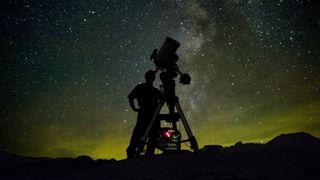Long nights in December 2023 will let you see many bright planets in the sky.
During December, Jupiter dominates the evening sky, while Venus continues to serve as a beacon in the predawn morning sky. While dimmer than Jupiter, Saturn too is conspicuous in the southern sky at nightfall. The ringed planet appears a bit brighter than it really is because it's positioned in a region of the sky where comparison stars are primarily dim.
Mercury shuttles from the evening sky early in the month, to the morning sky late in the month. The only planet out of the loop is Mars, which transitioned from the evening to the morning sky during November and is still much too close to the sun's vicinity to be seen during December. And lastly, the winter season officially kicks off — astronomically — with rays of the sun shining directly down on the Tropic of Capricorn — the solstice — on Dec. 21.
Related: Night sky, November 2023: What you can see tonight [maps]
Read more: Best telescopes for seeing planets in 2023

Looking for a telescope to see the planets in August? We recommend the Celestron Astro Fi 102 as the top pick in our best beginner's telescope guide.
In our schedule, remember that when measuring the angular separation between two celestial objects, your clenched fist held at arm's length measures roughly 10-degrees. Here, we present a schedule below which provides some of the best planet viewing times as well directing you as to where to look to see them.
Be sure to check out our best telescopes for viewing planets guide and our more general guides for the best binoculars and the best telescopes. If you're interested in taking your own impressive skywatching images, we have recommendations for the best cameras for astrophotography and the best lenses for astrophotography.
The sun

The sun — Arrives at the December solstice in Sagittarius on Dec. 21 at 10:27 p.m. EST (0327 GMT Dec. 22). This event marks the beginning of winter in the northern hemisphere, and summer in the southern.
Mercury

Mercury — Reaches greatest elongation east (21 degrees from the sun and magnitude -0.2) on Dec. 4, when the planet sets in the southwest only 1 hour and 15 minutes after the sun. Mercury's sighting will be a very low apparition for viewers at mid-northern latitudes. From now through Dec. 13, the planet is visible six degrees above the southwest horizon for a half hour after sunset. During this period, the planet fades from magnitude -0.4 to +0.5 as its phase wanes from 62% to 28% lit by the sun. After Dec. 13, Mercury fades precipitously and drops rapidly, and it soon becomes a difficult target even for binoculars and telescopes. On Dec. 22, Mercury passes through inferior conjunction, but then brightens four magnitudes in little more than a week, and climbs into view before sunrise. By New Year's Eve, ochre-hued Mercury has brightened to magnitude +0.8 and is just visible above the southeastern horizon a half hour before sunrise.
Venus

Venus — Is resplendent in the morning sky despite dimming slightly, from magnitude -4.2 at the beginning of December to -4.1 at the end. The planet loses about an hour of its lead on the sun this month, but even at month's end it still rises almost three hours before sunup; that makes Venus a dazzling "star in the east" for the 2023 holiday season. Venus still appears large and obviously gibbous through telescopes, though not as spectacular as it was during its thin crescent phase last August and September. The planet's disk waxes from 68% to 78% illuminated by the sun during December, while its apparent diameter shrinks by 17%. On the morning of Dec. 9, look low toward the east-southeast this morning at around 5 a.m. to catch sight of a lovely tableau consisting of Venus, sitting about four degrees to the upper left of a slender crescent moon.
Mars

Mars — Having passed through solar conjunction last month, Mars is out of sight all of December, still hopelessly buried in the glare of the sun.
Jupiter

Jupiter — Comes into view almost halfway up in the southeastern sky at dusk. The giant planet hangs near the borders of Aries, Pisces and Cetus, shining highest in the south around 8:30 p.m. local time and setting in the early hours of the morning. On the evening of Dec. 21, you will see the waxing gibbous moon positioned about eight degrees to the right of Jupiter. On the following evening, the moon will have shifted to a point sixdegrees to the left of the big planet.
Saturn

Saturn — Is due south at nightfall when December begins, a little west of south as the weeks goes by. Note Saturn's position against the background stars, and you will see the planet picking up speed as it moves eastward with respect to the dim stars of central Aquarius. During December, Saturn's brightness fades a trifle. In a telescope its rings close a bit, from 10 degrees to 9 degrees. Saturn sets in late evening all through December. At dusk on the evening of Dec. 17, take note of Saturn hovering about three degrees above a fat waxing crescent moon.
Editor's Note: If you get a great photo of any of the planets and would like to share it with Space.com's readers, send your photo(s), comments, and your name and location to spacephotos@space.com.
Joe Rao serves as an instructor and guest lecturer at New York's Hayden Planetarium. He writes about astronomy for Natural History magazine, the Farmers' Almanac and other publications.


